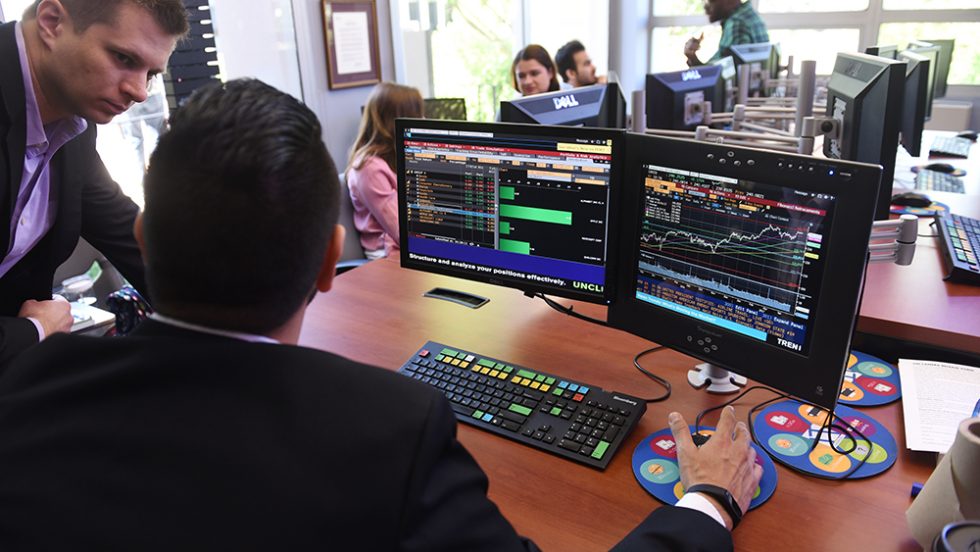
Adelphi finance students not only learn how institutional investors manage large portfolios, they manage a portfolio themselves, in the real stock market, using some of the University's money.
In the James Riley, Jr. Trading Room in the Hagedorn Hall of Enterprise, Adelphi finance students not only learn how institutional investors manage large portfolios, they manage a portfolio themselves, in the real stock market, using some of the University’s money.
It’s one of the best ways to hit the ground running once students enter the world of professional finance, according to Rajib Sanyal, Ph.D., dean of the Robert B. Willumstad School of Business. Each semester, about 15 Adelphi students take a course, Student Investment Fund, in which they review the fund’s existing portfolio of stocks and bonds. They then get three opportunities each semester to recommend adjustments based on their own research and analysis.
The investment fund is part of the University’s endowment. And, Dr. Sanyal said, it’s an excellent use of resources to give students real-world experience.
“When you are learning to fly a plane, you start out in a simulator,” he said. “That way, if you crash, it’s not the end of the world. And you get to be in an environment that’s very much like the real thing,” he said.
The fund was started in 2008 with a gift from James Riley, Jr., a former managing partner at Goldman Sachs and a benefactor of Adelphi University. Over the last 10 years, Dr. Sanyal said, the student-controlled fund has grown from about $100,000 to a $350,000 portfolio of stocks, bonds and commodities.
Students do the number crunching and macroeconomic analysis needed to make investment recommendations using Bloomberg terminals, one of the tools available to financial professionals. The terminals, which are in the Riley Trading Room, are specialized hardware with software that provides access to timely, accurate information on thousands of companies, commodities and investment instruments. The terminals also provide detailed historical information on companies and markets stretching back decades, allowing investors to make informed decisions, said Robert S. Goldberg, clinical assistant professor of finance and economics.
Students prepare three major investment recommendations each semester. For each recommendation, they make a formal presentation to the University’s chief financial officer and a panel of finance professionals that includes members of the business faculty.
“For me,” Goldberg said, “the point of all this, besides using the equipment, is that students learn what it means to be a professional. Those presentations need to be perfect.”
Goldberg said that by the time the students make their case to the panel, they have seen their presentation through sometimes a dozen drafts. He demands that the written portion of the presentations be completely sound, from the biggest ideas down to the smallest punctuation marks.
“That’s how it is in the professional world,” Goldberg said. In the workplace, superiors and clients expect finance graduates to be professional and credible. It’s at these presentations that students get their first taste of what that kind of credibility requires, he said.
Ultimately, Adelphi’s CFO and business office must execute the trades, but, Goldberg said, the University almost always follows the students’ recommendations. The only times the University hasn’t followed the students’ advice, he said, was on rare occasions when students recommended a stock or a bond that the University wasn’t permitted to buy, according to Adelphi’s own investing rules.
“They have made recommendations that I personally disagreed with, that I wouldn’t have done myself, but they had reasoned, sound arguments, and we do them,” Goldberg said.